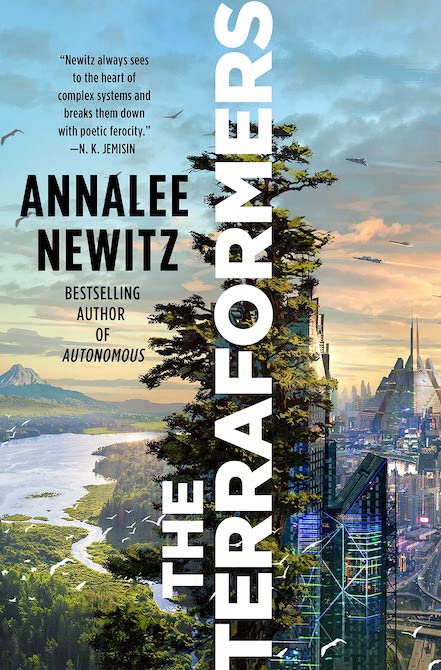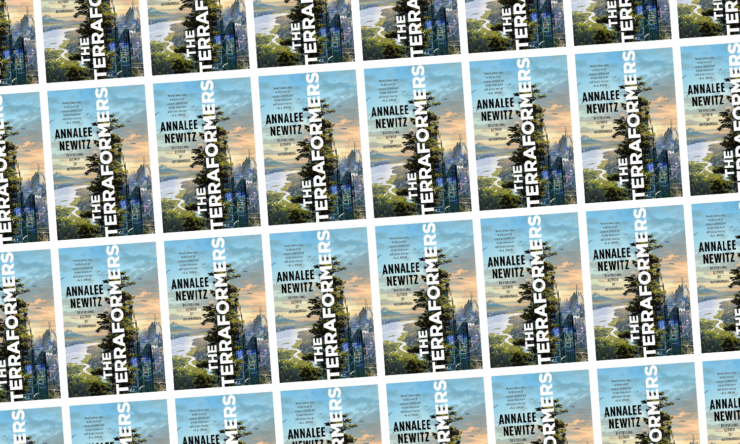Building a new Earth-like planet is tricky, for a number of reasons.
From the outset of the first novella-length segment of Annalee Newtiz’s The Terraformers—one of three, spanning thousands of years in total—the fundamental theme at the heart of this book is clear: what is the healthiest way of creating a truly sustainable, open, and free civilization in a future that makes almost anything possible, and how do you navigate conflict on a planetary level? Through the lens of the history of Sask-E’s development, Newitz explores questions of sentience, personhood, ecology, violence, infrastructure, politics, and more, as only they can: with intelligence, nuance, and above all, heart.
We first meet Destry of the Environment Rescue Team and her companion Whistle, a moose that functions as a Mount, built with a language blocker and a seemingly limited vocabulary. Destry, contracted to the company terraforming Sask-E, functions as essentially an environmental translator; using thousands of points of data from the soil, the air, the earth, she can tell when an ecosystem is out of balance. She ranges far afield, enjoying her time along with Whistle, when she comes across a tourist in a manufactured body—the child of an investor in their own drone, trying to enjoy “early Earth,” with the same godawful amount of privilege the elite enjoy nowadays as they do in the year 59,006.
Buy the Book


The Terraformers
This shake-up leads her to a major discovery of sentient peoples hiding within the subterranean caverns of Sask-E. A majority of early “distilled,” peoples, created by the company to breathe the pre-carbon air of Sask-E and designed to expire after their time was done, did not expire. In fact, they’ve got their own civilization in a dormant volcano, a breadth of intelligent animals in their community, as well as sentient programs within their tech, and they’re all asking for the same thing: autonomy from the company Verdance and an equal share of the planet they started to help terraform. And if Verdance won’t give it to them, they have a means of procuring it for themselves.
From here, and across the two other novellas in which Newitz documents the ripples and repercussions of this first situation, we see them engage in the real, complex, fascinating, and often struggle of civilizations coming to terms with one another. And whether it’s the year 59,006 with the right to be recognized as a sentient community of peoples, or 700 years later as communities attempt to wrest mass transit decisions into the hands of those communities affected by the need to travel, or 900 years after that, as a gentrification and housing crisis of epic proportions affects all lifeforms on Sask-E, even the sentient earthworms. Newitz is a detailed and thoughtful writer of the speculative, taking the time to not just get into the nitty-gritty of negotiation, the rights of sentient peoples, and the tectonic shifts necessary to ensure that living peoples have respect and dignity in their pursuit of their rights, but they also take the time to get into those relatable, little details that make people, well, people. Whether it’s a family of naked mole rats talking about their familial responsibilities within a dormant volcano, a bunch of earthworm engineers arguing about video game design, or the sexual cultures of organic peoples, machine peoples, and even flying train peoples, Newitz takes care and takes time to show us that the future will have just as much fun and inventive forms of culture, play, identity, music, history, and more, delving with glee into the many thought experiments they set up nearly a millennia prior. It is riveting, it is engaging, it is Newitz, pure and simple.
While they take the time to build out unique characters throughout the years, it is in each of these character’s relationships to the novellas previous or years to come that create the most beautiful and bittersweet moments. Destry puts her life on the line to create an opportunity for the denizens of the underground volcano to live free of Verdance; it is her replacement seven hundred years later who pays the price for her actions. Whistle, the Mount yearning for sentience and language, finally gets to make a mark on a cat being created. Thousands of years later, that cat has become a reporter, and named himself after the person who marked him as his own.
The struggle for civilization and the rights of sentient beings may in fact take millennia when working against the corporate interests of elite powerbrokers, hungry to control a planet they own but have never stepped foot on. But as Newitz beautifully posits in this truly incredible novel and thought experiment: the work may take a long time, but it is work that will be carried on by generations to come, educated and loved by those who came before. It is these generations who will continue to fight and ensure rights for all. And if we can take a lesson from the year 60,610 and bring it to our own modern day, it is that when we fight together, present and future, we can win, with dignity, joy, and rights for all.
The Terraformers is published by Tor Books.
Read an excerpt here.
Martin Cahill is a writer living in Queens who works as the Marketing and Publicity Manager for Erewhon Books. He has fiction work forthcoming in 2021 at Serial Box, as well as Beneath Ceaseless Skies and Fireside Fiction. Martin has also written book reviews and essays for Book Riot, Strange Horizons, and the Barnes and Noble SF&F Blog. Follow him online at @mcflycahill90 and his new Substack newsletter, Weathervane, for thoughts on books, gaming, and other wonderfully nerdy whatnots.










